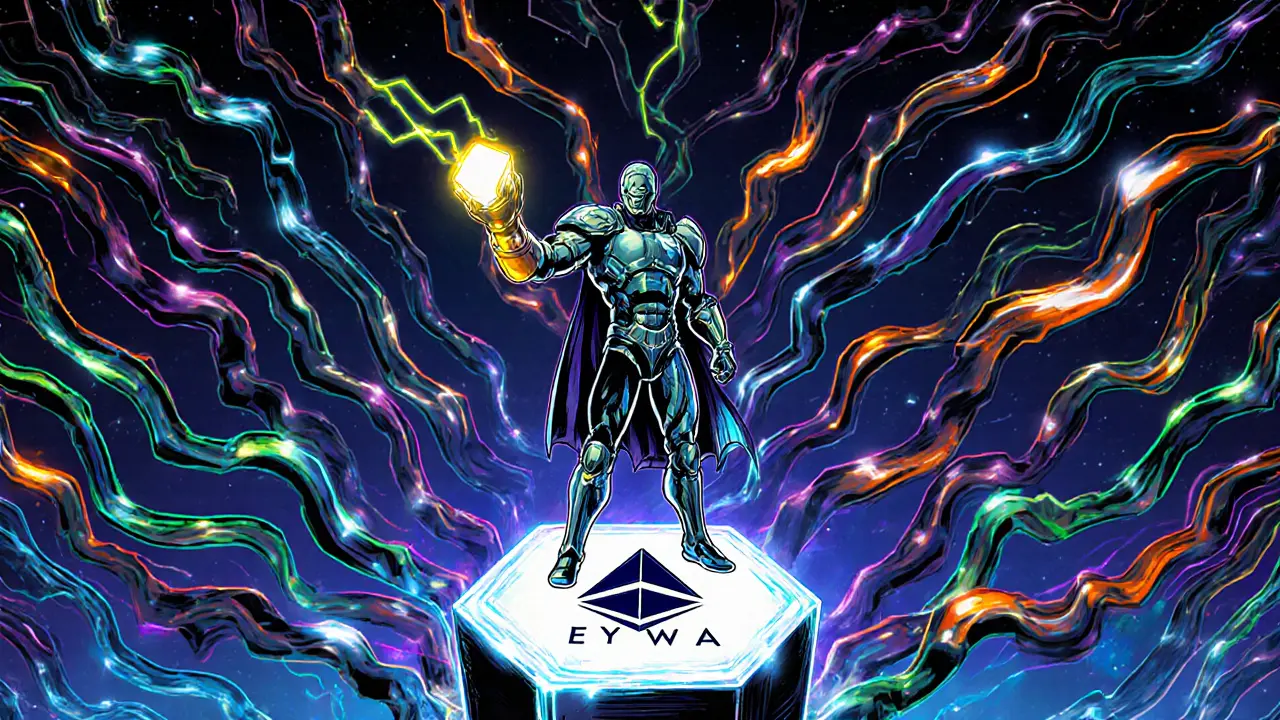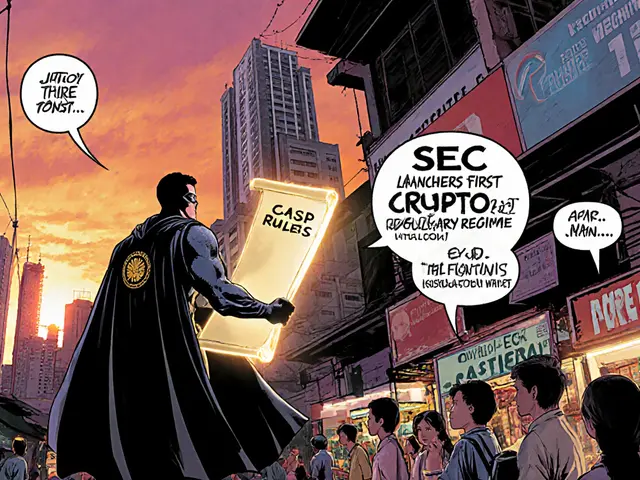EYWA (EYWA) Crypto Coin Explained: How the Cross‑Chain Interoperability Token Works
EYWA Token Value Calculator
Current EYWA Token Metrics
Total Supply
1,000,000,000 EYWA
Circulating Supply
~200,000,000 EYWA
Current Price
$0.0121
Market Cap
$1,210,000
Investment Scenario Calculator
Estimate potential returns and risks based on your investment amount
Results Summary
When you hear the buzz around EYWA cryptocurrency is a blockchain‑based token that powers a decentralized cross‑chain liquidity and data protocol. In plain English, EYWA aims to glue together separate blockchains so that assets and information can move freely without the usual bottlenecks.
Key Takeaways
- EYWA combines a multi‑bridge consensus system (Consensus Bridge) with Curve Finance’s deep liquidity pools (CrossCurve).
- It supports more than 20 EVM‑compatible networks, including Ethereum, Polygon, BNB Chain, Fantom, Avalanche and Arbitrum.
- Token supply is capped at 1billion, with roughly 10% circulating and 90% locked.
- Funding totals about $8.5million, backed by Curve, 1inch, Fenbushi Capital and other DeFi veterans.
- Risks include high price volatility, reliance on external bridge providers and limited developer activity.
How EYWA Makes Cross‑Chain Moves Possible
The protocol is built on two core components that work together like a relay race.
Consensus Bridge is a trustless token and data bridge that doesn’t put all its eggs in one basket. Instead of relying on a single bridge, it aggregates the security guarantees of four well‑known networks: Axelar, Chainlink CCIP, LayerZero and Wormhole. By taking a consensus of their validations, the bridge reduces the chance that a single point of failure compromises a transfer.
The second half, CrossCurve, plugs EYWA into Curve Finance’s ultra‑deep liquidity pools. Curve is famous for low‑slippage stablecoin swaps, and CrossCurve borrows that efficiency for cross‑chain trading. When you send assets from Ethereum to Polygon, for example, CrossCurve routes the trade through Curve’s pools, giving you better rates and less price impact than a naïve bridge‑only approach.
Tokenomics at a Glance
Understanding the numbers helps you gauge both upside and risk.
- Total supply: 1billion EYWA tokens.
- Circulating supply: ~200million (about 10%).
- Current price (Oct2025): roughly $0.0121 per token (CoinMarketCap). Prices swing widely; the 90‑day drop sits near 75%.
- Market cap: ~US$1.2million.
- Unlock schedule: 90% of tokens remain locked, with future releases potentially pressuring price.
Token utility falls into three buckets: governance (through the EYWA DAO), liquidity incentives for providers, and fee discounts for bridge users. Holding EYWA lets you vote on protocol upgrades, fee structures and new network integrations.
How EYWA Stacks Up Against the Competition
| Protocol | Bridge Model | Security Approach | Supported Chains (EVM) | Curve Integration |
|---|---|---|---|---|
| EYWA | Multi‑bridge consensus (Axelar, Chainlink CCIP, LayerZero, Wormhole) | Aggregated validation across four providers | 20+ | Yes (CrossCurve) |
| LayerZero | Omnichain messaging | Single‑provider oracle + relayer | 30+ | No |
| Wormhole | Validator‑based token bridge | Set of trusted guardians | 25+ | No |
EYWA’s unique selling point is the blend of multiple bridge security layers *and* direct access to Curve’s pools. That combination promises lower slippage and higher capital efficiency, but it also means EYWA depends on the health of four third‑party bridge networks.

Funding, Partnerships, and Community Pulse
The project has attracted serious institutional interest. A $7million seed round led by Curve’s founder Michael Egorov closed in May2024, followed by an additional round in December2024 with backers including the 1inch co‑founder and Kenetic Fund. Total disclosed financing sits around $8.5million.
Grants from Harmony, NEAR and Algorand signal early ecosystem validation, though those grant programs are currently dormant. Development activity on GitHub has slowed, a red flag for long‑term sustainability, yet the partnership with Curve continues to generate buzz among liquidity providers.
Community chatter is modest; discussion forums mention the protocol’s technical depth as both a draw for developers and a barrier for retail users. The lack of a vibrant retail community keeps trading volume thin, contributing to the observed price volatility.
Risks You Should Keep in Mind
- Bridge dependency: EYWA’s security model leans on Axelar, Chainlink CCIP, LayerZero and Wormhole. Any breach in one of those could affect EYWA transfers.
- Token unlock pressure: With 90% of tokens locked, future vesting events could flood the market.
- Thin liquidity: Daily volume hovers under $300k, meaning large trades may move the price noticeably.
- Developer momentum: Sparse recent commits raise questions about roadmap execution.
Getting Started with EYWA
If you’re curious enough to hold or use EYWA, here’s a quick checklist:
- Set up a wallet that supports EVM chains (MetaMask, Trust Wallet, etc.).
- Buy EYWA on a decentralized exchange that lists the token - most often you’ll find it on Curve’s cross‑chain DEX or on Uniswap’s bridged markets.
- Bridge your EYWA tokens using the Consensus Bridge interface; select source and destination chains, then confirm the transaction.
- If you want to earn rewards, provide liquidity to a CrossCurve pool. The protocol will automatically allocate a portion of swap fees to LPs.
- Participate in governance by staking EYWA in the EYWA DAO portal. Proposals range from fee adjustments to adding new chains.
Always double‑check contract addresses and use the official eywa.io site to avoid phishing scams.
Future Outlook
The cross‑chain space is heating up, and EYWA’s multi‑bridge approach could become a differentiator if the team can maintain high uptime across all four providers. Success will likely hinge on three factors:
- Security track record: Demonstrating that no single bridge compromise can jeopardize funds.
- Liquidity growth: Attracting more LPs to CrossCurve to boost trading depth and reduce slippage.
- Developer adoption: Shipping new SDKs, APIs and documentation that make it easy for other projects to plug into the EYWA ecosystem.
If those boxes get ticked, EYWA could evolve from a niche interoperability experiment into a staple of multi‑chain DeFi. Until then, treat it as a high‑risk, high‑potential asset.
Frequently Asked Questions
What problem does EYWA aim to solve?
EYWA tackles liquidity fragmentation and insecure cross‑chain communication by combining multiple bridge validators with Curve’s deep liquidity pools, enabling assets to move smoothly across dozens of blockchains.
How is the Consensus Bridge different from single‑bridge solutions?
Instead of trusting one bridge, the Consensus Bridge aggregates confirmations from Axelar, Chainlink CCIP, LayerZero and Wormhole. A transaction is considered final only when a majority of these providers agree, lowering the chance of a single point of failure.
Where can I buy EYWA tokens?
EYWA is primarily available on decentralized exchanges that integrate the CrossCurve DEX, such as Curve’s own UI, Uniswap (via bridged pools) and occasionally on smaller DEXs on Polygon or BNB Chain.
What are the main risks of holding EYWA?
Key risks include high price volatility, dependence on external bridge providers, a large future token unlock schedule, and relatively thin market liquidity that can cause large price swings.
How does governance work in the EYWA DAO?
EYWA token holders can lock their tokens in the DAO portal to vote on proposals ranging from fee adjustments to adding new chains. Each token typically grants one vote, and proposals pass when a quorum and a majority threshold are met.






17 Comments
Jan B.
June 26 2025Nice breakdown of EYWA's architecture.
MARLIN RIVERA
June 26 2025EYWA's multi‑bridge approach is a marketing gimmick that masks a fragile security model; aggregating four bridges only multiplies potential points of failure.
Debby Haime
June 26 2025Wow, the way EYWA combines Curve's deep liquidity with a consensus bridge is pretty exciting – it could really smooth out cross‑chain swaps for everyday users.
emmanuel omari
June 26 2025From my perspective the real value of EYWA lies in its ability to showcase African blockchain innovation on a global stage, proving that we can compete with Western protocols.
Andy Cox
June 26 2025looks solid but i wonder how many devs actually use it
Courtney Winq-Microblading
June 26 2025Imagine a world where tokens glide between chains as effortlessly as thoughts wander through consciousness; EYWA teeters on that philosophical edge, urging us to rethink the very notion of digital sovereignty.
Sophie Sturdevant
June 26 2025Liquidity providers should definitely consider staking EYWA in the CrossCurve pools – the fee‑rebate mechanism and governance voting rights create a compelling incentive structure for maximizing APY.
katie littlewood
June 26 2025The EYWA project, at first glance, reads like a masterclass in cross‑chain engineering.
Its dual‑layer design-Consensus Bridge paired with CrossCurve-promises to tackle both security and slippage concerns that have plagued older bridges.
By pulling validation from Axelar, Chainlink CCIP, LayerZero and Wormhole, the system builds a consensus that is harder to compromise than any single‑provider model.
At the same time, integrating directly with Curve’s ultra‑deep liquidity pools means traders can enjoy near‑zero price impact when moving assets across ecosystems.
This synergy could be a game‑changer for DeFi newcomers who have been intimidated by the technical barriers of multi‑chain arbitrage.
Moreover, the tokenomics, with only ten percent of supply currently circulating, suggest that early adopters might reap significant upside if the platform gains traction.
Of course, the lock‑up of ninety percent of tokens raises legitimate concerns about future sell pressure, but it also signals a commitment to long‑term alignment of incentives.
The governance model, which lets EYWA holders vote on fee structures and new chain integrations, adds a layer of community stewardship that many rival projects lack.
From a developer’s standpoint, the open‑source SDKs and comprehensive documentation are still a work in progress, yet the existing APIs already enable seamless bridge calls.
Partnerships with heavyweights like Curve, 1inch and Fenbushi Capital provide both credibility and a runway for ecosystem growth.
On the flip side, daily trading volume remains modest, hovering under $300k, which could lead to noticeable price swings on larger trades.
The reliance on external bridge providers also means that any security breach in one of them could cascade into EYWA’s ecosystem, a risk that cannot be ignored.
Still, the diversified validator set offers a degree of redundancy that many single‑bridge solutions simply do not possess.
If the team can sustain developer activity and attract more liquidity providers, the protocol may evolve from a niche experiment into a cornerstone of multi‑chain DeFi.
In the broader crypto landscape, where interoperability is becoming a prerequisite rather than a luxury, EYWA’s approach feels both timely and ambitious.
Ultimately, investors should weigh the high‑risk, high‑potential profile of EYWA against their own tolerance for volatility, but the underlying technology certainly warrants a closer look.
Jayne McCann
June 26 2025I doubt EYWA will survive the next wave of bridge hacks.
Richard Herman
June 26 2025It's encouraging to see the community slowly growing around EYWA; a supportive forum can help mitigate the knowledge gap for newcomers.
Parker Dixon
June 26 2025😅 While the bridge aggregation does add complexity, remember that diversifying validators can actually improve resilience compared to relying on a single point of failure.
Stefano Benny
June 26 2025🤔 Even with the hype, the tokenomics still look like a classic liquidity‑drain scenario; unless the vesting schedule is restructured, price stability remains elusive.
Bobby Ferew
June 26 2025It's a bit sad seeing so few developers jump on board; the project's future feels like a lonely lighthouse in a foggy sea.
celester Johnson
June 26 2025One must critically assess whether philosophical musings translate into tangible utility; otherwise, the protocol risks becoming an academic exercise.
Prince Chaudhary
June 26 2025Let's stay constructive – the challenges you mention are real, but they also present opportunities for the team to reinforce security measures.
John Kinh
June 26 2025meh, sounds cool but I’m not convinced enough to dump my funds there 😒
Mark Camden
June 26 2025From an ethical standpoint, promoting a token with such a thin liquidity pool may encourage speculative excess, which contradicts the responsible stewardship we should uphold.